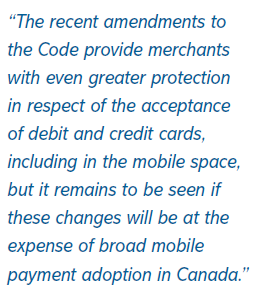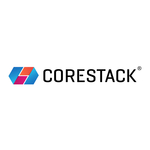Viewpoint: Canada’s Regulation of Mobile Payments: Merchant Protection at the Cost of Innovation?
 Some of the most significant changes to Canada’s Code of Conduct for the Credit and Debit Card Industry affect the rights of merchants regarding mobile and contactless payments. In this Paybefore Viewpoint, Attorney Jacqueline Shinfield presents the facts and questions whether the updated Code will have the unintended consequence of disincenting investment in and adoption of innovative payment technologies in Canada.
Some of the most significant changes to Canada’s Code of Conduct for the Credit and Debit Card Industry affect the rights of merchants regarding mobile and contactless payments. In this Paybefore Viewpoint, Attorney Jacqueline Shinfield presents the facts and questions whether the updated Code will have the unintended consequence of disincenting investment in and adoption of innovative payment technologies in Canada.
By Jacqueline Shinfield, Blakes
Amendments made to the Code of Conduct for the Credit and Debit Card Industry in Canada (Code) released by the Department of Finance on April 13, 2015, will have interesting repercussions across the entire Canadian payment industry, affecting not only payment card networks but also acquirers, issuers and mobile app developers, among others.
 The Code came into force in 2010 and was implemented as a form of “consumer protection” for merchants, ensuring that merchants were aware of the costs of accepting credit and debit cards and providing merchants with flexibility in determining what payment options to accept.
The Code came into force in 2010 and was implemented as a form of “consumer protection” for merchants, ensuring that merchants were aware of the costs of accepting credit and debit cards and providing merchants with flexibility in determining what payment options to accept.
The recent amendments to the Code provide merchants with even greater protection in respect of the acceptance of debit and credit cards, including in the mobile space, but it remains to be seen if these changes will be at the expense of broad mobile payment adoption in Canada.
The FAQs on the Department of Finance’s Website in respect of amendments to the Code provide that payment card networks, issuers and acquirers will have 30 days from the Code’s release date (April 13, 2015) to publicly recommit to the Code (Code adoption date). All Code amendments will then apply within nine months of the Code adoption date, subject to certain exceptions noted below.
The following is a high-level summary of the more significant changes made to the Code, including those made with respect to the acceptance of mobile payments. Other changes to the Code deal with enhanced disclosure requirements for merchant acquiring agreements, and requirements for acquirers and payment card networks to have robust complaints processes and procedures.
Elements 1 and 12: Increased Transparency and Disclosure by Payment Card Networks and Acquirers to Merchants; Limitations on Automatic Renewals
The Code currently imposes certain disclosure requirements upon acquirers with respect to monthly statements and acquiring agreements to ensure that relevant information is provided to merchants in a transparent manner. The Code enhances these disclosure obligations by requiring the inclusion of an information summary box and a fee disclosure box as a cover page to acquiring agreements, which discloses in a more simplified manner, relevant information in respect of merchant acquiring agreements. A template of the form of information box and fee disclosure box are provided as an addendum to the Code. The information and fee summary box requirement—and other new disclosure obligations under Element 1 of the Code—apply 18 months from the Code adoption date. As a result, acquirers will be required to update their standard form agreements and provide more pointed disclosures.
As part of the commitment to enhanced disclosure, Code Element 12 provides that information about merchant acquirer agreements, including cancellation and renewal terms and conditions, must be disclosed in a manner that is clear, simple and not misleading.
In addition to these disclosure requirements, Code Element 12 also provides merchants with new and greater rights under their acquiring agreements. As a starting point, merchants now will be allowed to provide notice of non-renewal of their acquiring agreements at any time during the term of the contract period, up to 90 days prior to contract expiry. This right will come into force immediately upon the Code adoption date. Moreover, fixed-term merchant acquiring agreements will not automatically renew for the full initial term but rather may convert to automatically renewable extensions of not more than six months. Merchants may provide notice of non-renewal at any point during an extension period, up to 90 days prior to the end of each term.
As such, any fixed-term merchant acquiring agreement that expires in circumstances where there has been no action taken by a merchant to cancel the agreement prior to expiry only will be allowed to auto renew on a six-month basis. This requirement applies to both merchant acquiring agreements as well as any related service contracts with service providers. This requirement will come into force nine months from the Code adoption date. It should be noted that Code Element 12 only applies to standard form contracts; it is not intended to apply to custom contracts negotiated between parties where they have had the benefit of legal counsel.
Elements 2 and 3: Notice to Fee Adjustments and Corresponding Merchants’ Right to Cancel their Acquiring Agreements
While the Code has always required payment card networks and acquirers to provide notice to merchants of fee increases, the amendments to the Code now require payment card networks and acquirers to provide merchants with notice of reductions in interchange rates applicable to each individual merchant. In that regard, in November 2014, certain of the major payment card networks voluntarily agreed with the Department of Finance to reduce their interchange rates in Canada.
To ensure that the benefit of this interchange rate reduction is provided to merchants, the Code provides that in the event that acquirers do not pass through the full savings from any reduction to posted applicable interchange fees to individual merchants, merchants will have the right to cancel their merchant acquiring agreements without penalty on 90 days’ notice. This termination right applies not only to merchant acquiring agreements, but also to any related service contracts (e.g., terminal leases) brokered by the acquirer or its registered agents or processors (multiple service provider contracts). This termination comes right into force immediately upon the Code adoption date.
It is noteworthy that the Code requires the entire amount of the interchange reduction to be passed onto merchants. In other words, merchants are entitled to recoup the entire benefit of the interchange reduction or they are entitled to cancel their agreements. It will be interesting to see how the calculation of the “full savings” of interchange reductions is determined, given the inherent complexity in the calculation of interchange rates. It is also noteworthy that there is no corresponding requirement for merchants to pass on any related savings to consumers.
Element 11: Mobile and Contactless Payments
Some of the most significant changes to the Code address merchants’ rights in respect to the acceptance of mobile and contactless payments. All of these changes come into force immediately upon the relevant Code adoption date.
As discussed below, the changes to the Code provide merchants with the right to choose whether to accept contactless payments, no matter if the acceptance of contactless payments is cost neutral or even at a lower cost to merchants. It will be interesting to see if these merchant rights come at the expense of broad mobile adoption in Canada.
For mobile payments to become prevalent in the Canadian marketplace, they must be accepted by merchants. In that respect, a new Element 11 of the Code provides that merchants will not, in fact, be required to accept contactless payments (mobile or plastic) at the point of sale or be required to upgrade to POS terminals to enable such payments. Moreover, if a merchant chooses to accept contactless payments at the point of sale—whether by mobile device or otherwise—the Code allows the merchant to cancel contactless payment acceptance on 30 days’ notice, without otherwise altering or cancelling their merchant acquiring agreements.
 In addition, if the cost of mobile acceptance increases relative to other contactless acceptance, merchants can cancel the acceptance of mobile payments without cancelling other forms of contactless acceptance. In furtherance of this merchant right, payment card networks are tasked with developing “the technical specifications to ensure that merchant acceptance of contactless payments made from a mobile wallet or mobile device can be cancelled at the point of sale without disabling other forms of contactless payment acceptance.”
In addition, if the cost of mobile acceptance increases relative to other contactless acceptance, merchants can cancel the acceptance of mobile payments without cancelling other forms of contactless acceptance. In furtherance of this merchant right, payment card networks are tasked with developing “the technical specifications to ensure that merchant acceptance of contactless payments made from a mobile wallet or mobile device can be cancelled at the point of sale without disabling other forms of contactless payment acceptance.”
Given that the Code allows merchants full control over whether they wish to accept contactless payments (including mobile payments) and allows merchants to opt out of accepting mobile payments if the cost of acceptance increases, this uncertainty may prove to be a disincentive for mobile wallet providers, app developers, payment card networks and other technology-related service providers to allocate funds and resources for the development of new and innovative payment technologies for Canadian consumers.
Other Code Elements Affecting Mobile Payments
In respect of the application of current Code principles to the mobile space, Code Element 4, which provides that merchants are not required to accept both credit and debit payments from the same network, has been expanded to address mobile payments. In that respect, Code Element 4 now provides that merchants that accept a credit payment credential from a particular network accessed through a mobile wallet or other device will not be obligated to accept debit credentials from that network through a mobile wallet or other device and vice versa.
In addition, Code Element 6, which deals with the restriction on having competing debit applications on the same plastic card, also has been interpreted for application in the mobile environment. In that respect, Code Element 6 now provides that in mobile wallets (or on mobile devices), debit payment credentials from payment card networks must be represented as “separate payment applets.”
The Code defines a “payment applet” as a software application on a mobile device (or within a mobile wallet) that enables contactless payment by linking a single payment credential (e.g., credit or debit) through a specific payment card network.
Code Element 7 provides that co-badged plastic debit cards must be equally branded. Changes made to Code Element 7 to address mobile payments provide that all representations of payment applets in a mobile wallet or mobile device, and the payment card network brands associated with them, must be clearly identifiable and equally prominent.
In respect of default settings for mobile wallets, Code Element 8 provides that consumers are entitled to have full and unrestricted control over default settings on mobile devices and wallets. In keeping with this principle, consumers are to have the ability to change default settings on mobile devices/wallets and are entitled to select their own default preferences based on a clear and transparent process through the mobile user interface. In order to implement this requirement, the Code requires that payment card network rules are to ensure that consumers are entitled to full and unrestricted discretion to establish any default preference(s) for payment options. In that regard, credit and payment credentials for mobile devices are only to be issued by payment card networks to those mobile devices or wallets that do not have pre-set default preferences that cannot be changed.
The broadness of the application of the Code amendments outlined above will require payment card networks to ensure that their rules extend to all participants in the mobile ecosystem. This will serve to effectively create compliance oversight by payment card networks over not only acquirers and issuers—as is currently the case—but also over mobile device developers, app creators, mobile wallet providers and other technology service providers.
The amendments to the Code that address mobile payments seem somewhat inconsistent with the recommendations of the Task Force for the Payments System Review released in 2012 (Review). In the Review, the task force noted that the next wave in consumer payments would come from new mobile technologies and that to “take advantage of these innovations, government and industry must create the right conditions for the technology to thrive.” The Review also noted that the transformative power of a mobile ecosystem can be harnessed to “tip the scales towards broad adoption of such a system.” The provisions of the Code in respect of mobile payments seem somewhat inconsistent with “tipping the scales” to broad adoption where merchants have the unilateral right to refuse to accept contactless or mobile payments even on a cost-neutral basis. How this will play out in the Canadian marketplace remains to be seen.
Element 13: Dispute Resolution
One of the more interesting features of the Code that will ultimately allow the Financial Consumer Agency of Canada (FCAC) greater oversight over payment card network participants’ compliance with Code obligations is found in Code Element 13, which provides that payment card network rules are to allow merchants to have access to a clear dispute resolution process that provides for the investigation and timely response to Code complaints. The Code provisions in respect of the dispute resolution process will come into force within 60 days of the code adoption date.
Merchants shall have a right to report Code complaints to their acquirers, and the acquirer must review the issue and report back to the merchant within 90 days. If the acquirer has exhausted its complaints process and a satisfactory resolution is not achieved, the merchant is entitled to submit the complaint directly to the payment card network or the FCAC. As a result of this dispute resolution process, there will be direct dealings between payment card networks and participating merchants, which historically has not been the case.
Payment card networks also are required to investigate complaints received from their acquirers, as well as those received from the FCAC or directly from merchants. In these circumstances, they also are required to work with their participants to find an “appropriate resolution” within 45 days of receiving the complaint. It is unclear what an “appropriate resolution” means and the answer to this question is not contemplated by the Code.
In respect of the complaints process generally, payment card networks are required to receive reports from their acquirers in respect of the number and nature of all Code-related complaints and their outcomes on a semi-annual basis. This complaint information must then be provided by the payment card networks to the FCAC. This will provide the FCAC with greater insight into all Code-related complaints and may shape future Code amendments.
Element 9: Premium Cards
The Code currently has certain requirements in respect of premium cards, which are cards that have a higher interchange rate and generally offer attractive rewards and/or benefits to consumers. The current Code requirements for premium cards provide, among other things, that such cards should only be given to consumers who apply for or consent to such cards.
The amendments to Code Element 9 enhance the requirements for premium cards and require issuers to include a statement on all cardholder applications for premium cards prominently disclosing that these cards impose higher card acceptance costs on merchants. The intent behind this provision is to advise consumers that the card they are applying for will cost merchants more money to accept and presumably, by knowing this, consumers may choose to opt for another card. Of course, while this is not an issue for online applications, it will require issuers to reprint (or resticker) their credit card applications. Issuers will have nine months from the Code adoption date to implement this requirement.
Premium cards themselves also are now required to clearly indicate that they are premium products (e.g., display clear and prominent branding used by the payment card networks to identify them) and the same applies to payment applets that link to premium cards.
At the time that these Code amendments were released, the government also released a consultation paper entitled “Balancing Oversight and Innovation in the Ways We Pay.” Comments will be accepted on this consultation paper until June 5, 2015.
Jacqueline Shinfield is a partner in Blakes’ financial services regulatory group and can be reached at [email protected]. In 2015, she was recognized as a Top 10 Payments Lawyer in a poll of visitors to Paybefore.com. For further information, please visit www.blakes.com.
In Viewpoints, prepaid and emerging payment professionals share their perspectives on the industry. Paybefore endeavors to present many points of view to offer readers new insights and information. The opinions expressed in Viewpoints are not necessarily those of Paybefore.
© Blakes










































